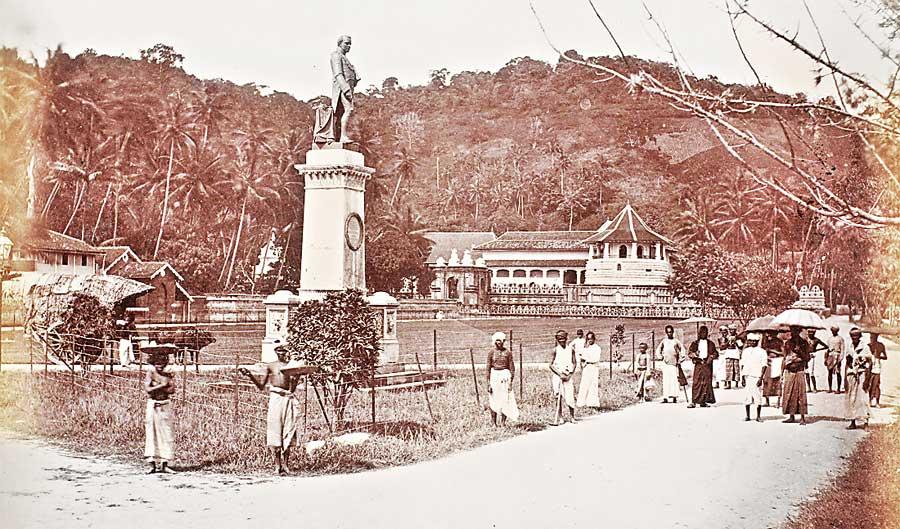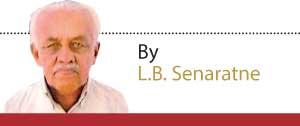Reply To:
Name - Reply Comment

Sir Henry Ward facing the Kandy Lake at the intersection of Sri Dalada Maligawa - this intersection is no more as it has become a part of Maha Maluwa.
British protesters seem to be on a spree to bring down statues connected with the slave trade, in the campaign Black Lives Matter the statue of Edward Colston was brought down in Bristol.
Now, another group, according to news from the United Kingdom is trying to protect the statues including the Cenotaph in Central London. At least some Britishers have seen sense.
Edward Colston was only a shareholder in the Royal African Company, where Royalty was at the helm and later to become King James II. Then his statues and that of the Royalty should be brought down before Edward Colston.
But as some moderate Englishman seems to think, they are part of the history and that of Colonialism.
If not one would have thought of bringing down the statue of Lord Baden Powell – the founder of the Scout Movement, as he is said to have suggested reading Mein Kampf of Hitler. But the statue was not brought down as there were Scouters, who protected it
In the same way, British protesters must realise that throughout the world during their rule, there are hundreds of statues erected in most countries, should they also be brought down? Then we are erasing history.
Like one at a commemorative meeting of Keppetipola Maha Nilame, Venerable Rajakeeya Panditha Niyangoda Vijithasri Anunayake Thera of Malwata Maha Vihare said that history changes and that does not mean that history should be erased.
"The British protesters must realise that throughout the world during their rule there are hundreds of statues erected in most counties, should they also be brought down? Then we are erasing history"
The world viewed on practically all Television channels the pulling down of Edward Colston dubbed as a Slave Trader.
But he was a shareholder in the Royal African Company, where Prince William was the head who later became
|
Statue of Edward Colston by John Cassidy, formerly in The Centre, Bristol, erected in 1895, toppled in 2020 |
King James II.
The business of the Royal African Company was bringing slaves from African countries to be sent to the Caribbean Islands and the Americas.
It is recorded that 100.000 slaves were brought and nearly 20, 000 of them died on the way and they were dumped at sea and out of the 3000 were children.
Edward Colston also built an empire of sugar factories worked by the slaves.
To pay for the sins he contributed much for schools and other philanthropic acts in Bristol, which opted to erect a statue in the heart of Bristol and named the area Colston Avenue as well, just on the side of the War Memorial.
It is said that the original site was removed to about one kilometre away when this statue was brought down by protesters of Black Lives Matter.
Colston is buried in St Catherine’s Church in Surrey. Now, the protesters are on the march to open up the grave to take what remains and dump it in the sea.
I had the opportunity to view this statue with a journalist friend of mine Rickard Douthwaite who worked in Oxford in the early 1960s I saw the marking on the plinth and asked him why a slave trader should have a statue in the heart of Bristol.
He said British Colonialism has not left their blood and perhaps it also a reminder to Colston that he is facing the dockyard where slaves were brought to be branded on their flesh RAC.
“You cannot blame Douthwaite, because he was a Scot,” he said.
The statue is of bronze and is about 20 feet high in a pensive mood. It took time to erect the statue as money was not forthcoming until a benefactor – a trader had given the money to erect the statue, for Colston’s philanthropic deeds.
With a few ropes and with a pull from the protesters the statue is said to have come down and was dropped into the dockyard waters, where slave ships would have come there at one time.
In Sri Lanka this writer had seen Peradeniya University students, around five hundred in all, during the Lumumba Protest making every effort to bring down the statue of Sir Henry Ward - once a journalist who edited the Chronicle and was also for a short time a Member of the British Parliament before he came to Ceylon.
The statue stood in front of the Sri Dalada Maligawa intersection. This statue had been erected by the people of Ceylon. for his contribution to the welfare of the natives.
Ward was responsible for the commencement of the railway, building of roads, the introduction of many utility matters and also a man who was with the natives of Sri Lanka.
At the height of Lumumba Protests, University of Peradeniya students, tired to bring down the statue placed on Ward Street then now Dalada Veediya.
"The statue of Slave trader Edward Colston was brought down in Bristol. Theere are hundreds of such Colonial vestiges. But then aren’t they erasing history as well? "
They failed and left with only a dent in the sword.
Then the Kandy Municipal Council democratically moved a resolution to move the statue and it was done. Of course, they never thought of where to install the statute after the removal.
There was a sense of respect and discipline among the so-called natives rather than the British protesters.
To remove the statue of Ward, it was entrusted to the Public Works Department (Now RDA). A young engineer came with a lorry and crane. He went up to the Statue, looked around and found no bolts or other accessory on which the statue stood.
He ordered the workman down to bring the chains and wrap
the Statue.
One experienced worker was heard to say “Mahatmayata pissue, meke kohamada galvane” (He is crazy. How can you remove this?). However, the workman wrapped the chains. The young engineer came down from the plinth of the statue and ordered the crane to lift. The statue was lifted and brought down on to the ground.
What is the theory? The engineer said.
“This statue has been built with precision and no bolts have been used. The statue has stood on the weight of the boots he was wearing. The entire weight had been in the boots.
While the statue was brought down, from nowhere came a loyal Royal Air Force Officer Wiggins and dropped down on the street and cried, as to what has he done against the people in the country to be treated in this manner. His son is still living in Kandy.
The Statute was taken to the Kandyan National Museum grounds and it stays there even today after years without a proper place.
Sir Henry Ward should have a place in the history of the country for what he has done to the Hill Country.
The British never liked him as he was with the natives. With his transfer to India, he died in Madras of Cholera.